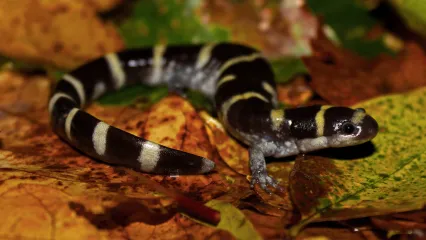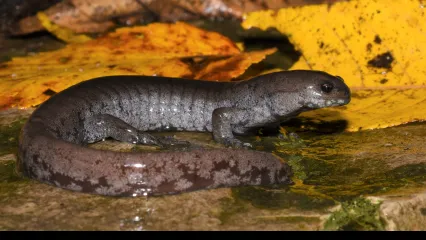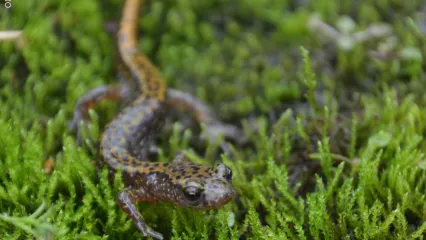
Description
Ringed salamanders are moderately large, stout salamanders with narrow heads and small eyes. Their name derives from their color pattern, which is black with narrow yellow rings. The yellow rings may or may not be complete across the back and they do not extend to the light-gray to yellow belly. On the tail, the rings are more distinct but also break on the underside. Ringed salamanders have long tails that are nearly round in cross section.
Size
Ringed salamanders can reach up to just over 9 inches in total length. Most adults vary from 5 1/2 to 7 inches in total length.
Habitat
The distribution of ringed salamanders in the United States is small, extending west to east from eastern Oklahoma through central Arkansas and north to south from southeastern Illinois to central Arkansas.
Life Cycle
Like other species of mole salamanders (genus Ambystoma) ringed salamanders spend most of the year underground, except for when they breed. Adult ringed salamanders migrate to temporary ponds during rainstorms in late fall. Migrations typically last only a few days. Once in the ponds, courtship occurs and males deposit a spermatophor on the pond bottom and females pick up the spermatophore with their cloaca. This usually occurs during the first or second night in the ponds, and by the third night, females have deposited their eggs. Eggs are deposited in large clumps of about 100 eggs, and the clumps are attached to vegetation in the water. The small eggs (about one-eighth of an inch in diameter) hatch in 9 to 16 days and the larvae spend the winter in the ponds. Larvae feed on a variety of aquatic invertebrates including ostracods and cladocerans.
As the larvae increase in size, they include larger invertebrates in their diets and occasionally eat other salamander larvae. Adults feed on a variety of invertebrates and likely eat a lot of earthworms.
How To Observe
Ringed salamanders are very difficult to observe, but it is possible to see them by visiting known breeding ponds at night during the first large rains in the fall. In Oklahoma, this species has a closed season and cannot be collected.
(This profile was created by Dr. Laurie Vitt as part of a partnership between the Wildlife Department and the Sam Noble Oklahoma Museum of Natural History. It was funded as part of a larger grant to survey and inventory amphibians and reptiles of the Wildlife Management Areas of Oklahoma: T-35-P-1.)


